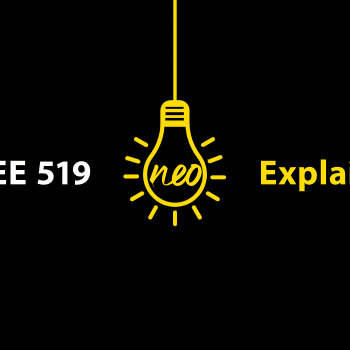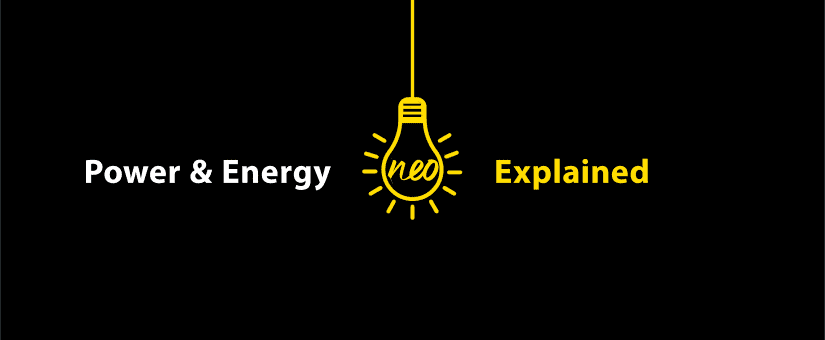
Electric Power & Energy Explained – Chapter 2
- Posted by Neo Messtechnik
- On 15. February 2021
- 0 Comments
Having the measurement know-how and right equipment in our hands, it’s on us to take the next steps. But what do we need to do for determining Electric Power and Energy? Without giving too much away – we will find the answers in the frequency domain. Please leave your Watt–meters at home.
Table of Contents
1 – Overview
Welcome to Chapter 2 of our Multipart-Series
We would like to start today’s article by expressing our gratitude for your feedback on our last chapter. If this is your first visit to our Power Quality Blog, here is a round-up on the first two articles.
3 – Power & Energy Analysis
Voltage measurement
Basically, the potential difference of two points defines the electric voltage. Measuring voltage with DAQ devices requires knowledge about the range of input signals (µV up to kV), using the right amplifiers and selecting the right measurement range. Furthermore it is important to consider ground loops, disturbances and noise signals.
Current measurement
Electric current basically flows when an electric circuit is closed and the potential difference of an energy source, e.g. battery, can be equalized. Basically, Ampere-meters measure current in series of the electric circuit. The drawback is that you need to open the circuit. Moreover, the input impedance of Ampere meters must be as low as possible to not affect the actual circuit too much.
In contrast, you measure electric current directly or indirectly using DAQ amplifiers for applications in the power and energy sector.
- The direct method involves opening the circuit/conductor to connect a sensor in series. Therefore, a Shunt resistor with a highly accurate and very low resistance value. The actual current value is determined by the means of the voltage drop-off over the Shunt and Ohm’s Law.
- In contrast, indirect methods allow current measurements via the magnetic field without the need of opening the circuit. Thereby, leading to galvanic isolation of the sensor from the conductor. For example, Rogowski coils, Hall compensated clamps or zero flux transducers work on these indirect principles among others.

More in-depth information
on these principles in the NEO current sensor manual. Easy accessible in your Download Area. Sign up!
Electric Power & Energy calculation
Electric Power is the product of current and voltage in every occurring moment. Using the integral over the cycle time T, it is equal to the mathematical sum. We can also understand power as energy flow in a certain time period. The unit of electric power is Watt [W].

Phase Lock Loop (PLL) synchronizes the sampling rate with the frequency of measured voltage signals. As we have already touched upon the beginning of this chapter, all of our devices ensure Class A power calculations. This is done on the basis of the period time in the frequency domain. First of all they carry out a FFT analysis on voltage and current, for 10/12 cycles and the specific sample rate. This gives us the amplitude and cos(phi) of every single harmonic.
By doing this, it is possible to consider amplifier or transducer shifts (amplitude or phase) that distort your results over the whole frequency range. By simply correcting them. Furthermore, this determination in the frequency domain also completely synchronizes all PQ parameters with the fundamental frequency of the measured system. Once the FFT values are corrected, the individual harmonic RMS values sum up to the respective total value for voltage or current. Which brings us to the calculation of the three main power quantities.
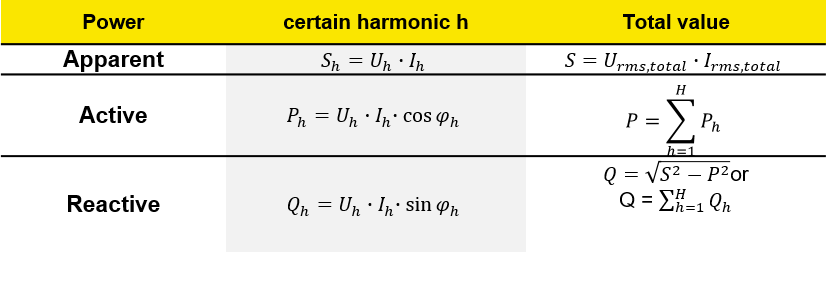
Transforming the classic power triangle
Apparently, the basic relationship of active and reactive power visually describes a triangle. While it is important to address, it mainly serves as basis for everything that is yet to come.

The classic power triangle
- Active Power P is transferred to the electric consumer/load and can be “used”. For example, being transformed to mechanical energy.
- Reactive Power Q is the natural part of the electric grid that is needed/provided for magnetic fields (motors, generators) of generators or capacitors. It symbolizes the unusable power part for the consumer and influences the transfer capacity. It only increases the system’s effort to deliver the same energy or rather power for a certain time period. In addition, it stresses power lines and engineers to compensate the reactive power. You find the positive or negative Q on the imaginary axis of the triangle.
Power Factor and Transferred Energy
- A high Power Factor equals high transmission efficiency. As you see in the formula above, this comes from the lower current flow and therefore losses in the system.
- The cos-phi gives the phase angle between the voltage and current of a certain harmonic. While the power factor takes the whole system into consideration, the cos-phi exists for each harmonic.
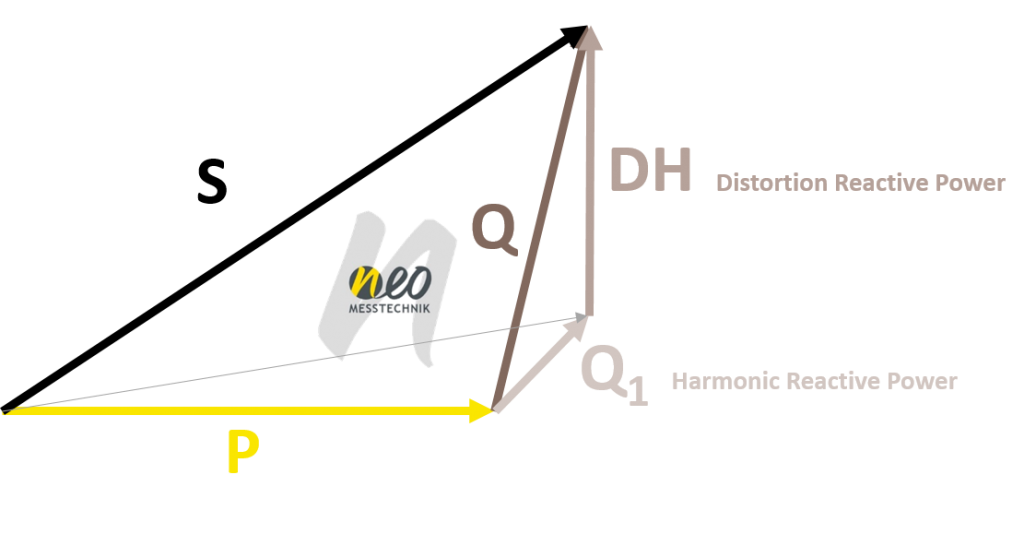
Introducing Distortion to the triangle
Inverters among other non-linear loads and especially renewable energy generation units (wind, PV) bring two new parameters into the triangle.
- Harmonic Reactive Power Q1,2,… of single harmonics result from phase shifts between the current and voltage of the respective harmonics. It’s sum brings us to the
- Harmonic Reactive Power QH

- Combining voltage and current quantities from different harmonics leads to the Distortion Reactive Power DH

- Considering all harmonics except the fundamental equals the Distortion D:

Phase angles
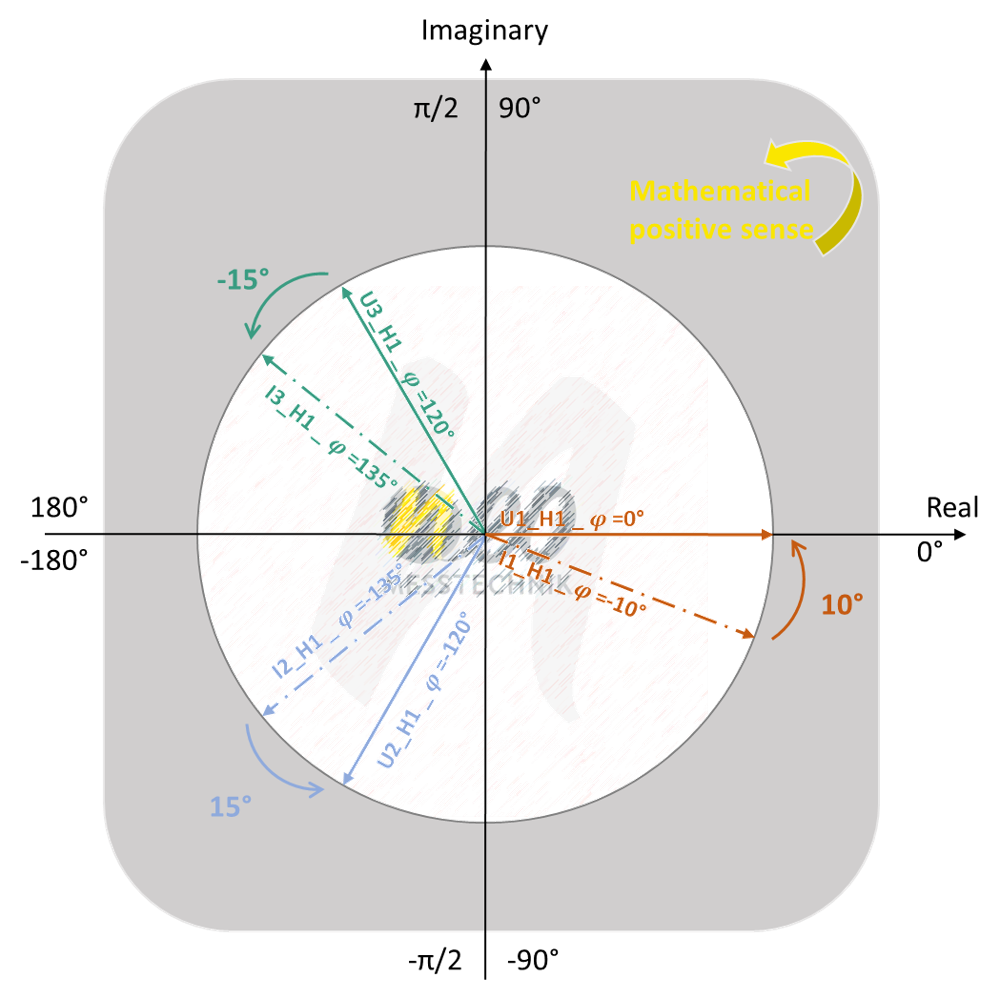
No more confusion.
The definition of phase angles and how values relate to each other always cause confusion and sometimes frustration. That’s the main reason we visualized our understanding that we use for NEO instruments.
The voltage of U_L1 is defined with 0°, being in line with the real axis, serving as the reference point to all phase angles. We will certainly come back to this image when we will be talking about phase angle jumps in the future.
Relationship Power & Energy

Energy & Efficiency calculation
We already defined electric power as the energy flow in a specific period of time. As a consequence, we can easily conclude to the calculation of energy consumption. The direction of the power flow thereby determines the sign (positive or negative) of the energy value. It defines if we are about consumed (positive value) or delivered energy (negative value).
These simple principles allow us to make conclusive statements about the energy flow and efficiency for various applications. The energy unit is Watthours [Wh]. Under efficiency we understand the ratio between output and input values of a system, whether it is power or energy efficiency. Efficiencies are always given in per cent [%].
4 – Powerful Summary. Energetic Outlook!
In this 3rd part of our Multi-Part-Series we talked about the essentials of frequency, voltage and current determination. While we touched upon the IEC 61000-4-30 Ed.3, we further focused on the (new) power triangle. The relation between power, energy and phase angles concluded today’s article.
Slowly but surely we are gaining some momentum here! As our knowledge builds up and we establish common ground, it allows us to cover increasingly exciting PQ topics in the future. For Chapter 4 we are planning to shine some light on the IEEE 519. Whether you are new to Power Quality or following this Blog to know exactly what NEO Messtechnik is currently up to – we hear you. Expect another refreshing take on another PQ parameter in Chapter 4.
Your NEO Messtechnik experts
Further reading
Chapter 3 – IEEE519 and Harmonics
There are actually more readings we highly recommend.. The first one is our LinkedIn presence, where we regularly update our followers on upcoming products, Blog Articles or AppNotes. In addition we take our chance to loosen up your LinkedIn timeline a little bit.
We previously published our first AppNote on Supraharmonics Influence on Power Line Communication (PLC) of Smart Meters. Make sure to register in our Download Area to secure a seat in the first row for all exclusive NEO content. We cannot wait to hear from you – we are are a simple phone call or E-Mail away:


